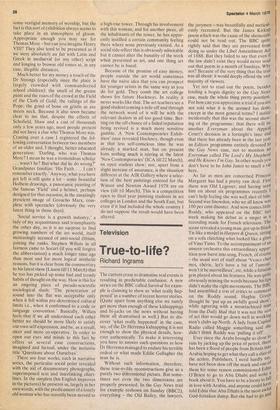Art
Socart
John McEwen
Just to remind you, "The King's Good Servant" Thomas More' (National Portrait Gallery) closes on 12 March. Apparently it has broken all attendance records; if you have not been let me give you some idea of what you are in for. No Roy Strong folde-rols for a start ŌĆö dribbling fountains, taped mandolin music and sonorous declamations, you know the sort of 'environmental' thing ŌĆö nothing like that. On the contrary this display is of the warren type: a twilit passage lined with show cases which occasionally disgorges its passengers into slightly larger chambers lined with pictures. I do not quite know how darkness has come to be associated with veneration, probably
some vestigial memory of worship, but the fact is this sort of exhibition always seems to take place in an atmosphere of gloom. Appropriate enough you may say for Thomas More ŌĆö but can you imagine Henry VIII? They also tend to be presented as if we were absolutely au fait with Latin and Greek in mediaeval (or any other) script and longing to browse old tomes at, in any case, illegible distances.
Much better for my money a touch of the Dr Strongs (especially since the place is largely crowded with commandeered school children): the smell of the grease paint and the roars of the crowd at the Field of the Cloth of Gold; the railings of the Pope; the grind of bone on gristle as axe meets neck. Because it also soon became clear to me that, despite the efforts of Schofield, Shaw and a cast of thousands only a few years ago, most people present did not have a clue who Thomas More was. Craning over a case I registered the following conversation between two members of an older and, I thought, better educated generation: 'Darling, who was Thomas More? I mean he was a tremendous scholar . . . wasn't he? But what did he do wrong?'
Grandpater familias: 'His Faith . I can't remember exactly.' Anyway, what you have got left is still quite a lot ŌĆö some beautiful
Holbein drawings, a panoramic painting of , the famous 'Field' and a helmet, perhaps designed for that occasion, in the amazingly
prescient image of Groucho Marx, complete with spectacles (obviously the very latest thing in those days).
'Social service is a growth industry,' a lady of my acquaintance said triumphantly the other day, so it is no surprise to find growing numbers of the art world, itself increasingly accused of anti-social elitism, joining the ranks. Stephen Willats in all fairness came to Socart (if you will forgive the abbreviation) a much longer time ago than most and for more logical aesthetic reasons, but it is clear from the commentary to his latest show (Lisson till 11 March) that he too has picked up some bad and trendy habits of thought on the way. How is this for an ongoing piece of pseudo-scientific sociological slush: 'The penetration of sound into the flat was acceptable only when it fell within pre-determined cultural limits i.e., when it conformed to a code or language convention.' Basically, Willats feels that if we all understood each other better we should be more likely to satisfy our own self-expression, and be, as a result, nicer and more co-operative. In order to open our eyes and minds to this fact he offers us several case constructions, imagined and factual, under the inclusive title 'Questions about Ourselves'.
There are four works, each in narrative series, the particular social point revealed with the aid of documentary photographs, superimposed text and interlinking chartlines. In the simplest (his English improves in the pictures) he presents us, largely in her own words, with the predicament of a lonely old woman who has recently been moved to a high-rise tower. Through his involvement with this woman, and for another piece, all the inhabitants of the tower, he has apparently instilled a certain community feeling there where none previously existed. As a social side-effect this is obviously admirable but it cannot alter the banality of the work when presented as art, and one thing art cannot be is banal.
Because of the promise of easy money, people outside the art world sometimes have the naive idea that you can prospect for younger artists in the same way as you do for gold. They comb the art college shows for future Hockneys. In reality it never works like that. The art teachers see a good student coming a mile off and through the network word of it will be with the relevant dealers in all too good time. Betting on the off-chance of a faded reputation being revived is a much more sensitive gamble. A 'New Contemporaries Exhibition' once revealed Hockney, though even in that less self-conscious time he was already a marked man, but on present form nothing much is stirring at the latest 'New Contemporaries' (ICA till 22 March), an open student show; nor, apart from a slight increase of assurance, is the situation. different at the AIR Gallery where a selection of the best paintings entered for the Winsor and Newton Award 1978 are on view (till 10 March). This is a competition open to final year painting students in art colleges in London and the South East, but even if it had included the whole country I do not suppose the result would have been altered.



































 Previous page
Previous page